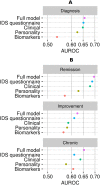Predicting the naturalistic course of depression from a wide range of clinical, psychological, and biological data: a machine learning approach
- PMID: 30397196
- PMCID: PMC6218451
- DOI: 10.1038/s41398-018-0289-1
Predicting the naturalistic course of depression from a wide range of clinical, psychological, and biological data: a machine learning approach
Abstract
Many variables have been linked to different course trajectories of depression. These findings, however, are based on group comparisons with unknown translational value. This study evaluated the prognostic value of a wide range of clinical, psychological, and biological characteristics for predicting the course of depression and aimed to identify the best set of predictors. Eight hundred four unipolar depressed patients (major depressive disorder or dysthymia) patients were assessed on a set involving 81 demographic, clinical, psychological, and biological measures and were clinically followed-up for 2 years. Subjects were grouped according to (i) the presence of a depression diagnosis at 2-year follow-up (yes n = 397, no n = 407), and (ii) three disease course trajectory groups (rapid remission, n = 356, gradual improvement n = 273, and chronic n = 175) identified by a latent class growth analysis. A penalized logistic regression, followed by tight control over type I error, was used to predict depression course and to evaluate the prognostic value of individual variables. Based on the inventory of depressive symptomatology (IDS), we could predict a rapid remission course of depression with an AUROC of 0.69 and 62% accuracy, and the presence of an MDD diagnosis at follow-up with an AUROC of 0.66 and 66% accuracy. Other clinical, psychological, or biological variables did not significantly improve the prediction. Among the large set of variables considered, only the IDS provided predictive value for course prediction on an individual level, although this analysis represents only one possible methodological approach. However, accuracy of course prediction was moderate at best and further improvement is required for these findings to be clinically useful.
Conflict of interest statement
B.W.J.H.P. received research funding (unrelated to the current paper) from Jansen Research and from Boehringer Ingelheim. A.B. received funding from Lundbeck and GlaxoSmithKline, also unrelated to this paper. The remaining authors declare that they have no conflict of interest.
Figures



Similar articles
-
Discovery of serum biomarkers predicting development of a subsequent depressive episode in social anxiety disorder.Brain Behav Immun. 2015 Aug;48:123-31. doi: 10.1016/j.bbi.2015.04.011. Epub 2015 Apr 28. Brain Behav Immun. 2015. PMID: 25929723
-
The three-year naturalistic course of major depressive disorder, dysthymic disorder and double depression.J Affect Disord. 2009 Jun;115(3):450-9. doi: 10.1016/j.jad.2008.10.018. Epub 2008 Nov 29. J Affect Disord. 2009. PMID: 19042028
-
Ten-year prospective follow-up study of the naturalistic course of dysthymic disorder and double depression.Am J Psychiatry. 2006 May;163(5):872-80. doi: 10.1176/ajp.2006.163.5.872. Am J Psychiatry. 2006. PMID: 16648329
-
The prevalence and severity of depressive symptoms along the spectrum of unipolar depressive disorders: a post hoc analysis.J Clin Psychiatry. 2013 Nov;74(11):1084-91. doi: 10.4088/JCP.12m08194. J Clin Psychiatry. 2013. PMID: 24330894
-
Understanding and predicting the longitudinal course of dementia.Curr Opin Psychiatry. 2019 Mar;32(2):123-129. doi: 10.1097/YCO.0000000000000482. Curr Opin Psychiatry. 2019. PMID: 30557268 Free PMC article. Review.
Cited by
-
Whole Person Modeling: a transdisciplinary approach to mental health research.Discov Ment Health. 2023;3(1):16. doi: 10.1007/s44192-023-00041-6. Epub 2023 Aug 24. Discov Ment Health. 2023. PMID: 37638348 Free PMC article. Review.
-
Mental health in the UK Biobank: A roadmap to self-report measures and neuroimaging correlates.Hum Brain Mapp. 2022 Feb 1;43(2):816-832. doi: 10.1002/hbm.25690. Epub 2021 Oct 28. Hum Brain Mapp. 2022. PMID: 34708477 Free PMC article.
-
Temporal multi-step predictive modeling of remission in major depressive disorder using early stage treatment data; STAR*D based machine learning approach.J Affect Disord. 2023 Mar 1;324:286-293. doi: 10.1016/j.jad.2022.12.076. Epub 2022 Dec 28. J Affect Disord. 2023. PMID: 36584711 Free PMC article.
-
A Fast and Minimal System to Identify Depression Using Smartphones: Explainable Machine Learning-Based Approach.JMIR Form Res. 2023 Aug 10;7:e28848. doi: 10.2196/28848. JMIR Form Res. 2023. PMID: 37561568 Free PMC article.
-
Prediction of Early Symptom Remission in Two Independent Samples of First-Episode Psychosis Patients Using Machine Learning.Schizophr Bull. 2022 Jan 21;48(1):122-133. doi: 10.1093/schbul/sbab107. Schizophr Bull. 2022. PMID: 34535800 Free PMC article.
References
Publication types
MeSH terms
LinkOut - more resources
Full Text Sources

